Positional Scale Fingerings
There are five basic Major scale fingerings. Each within a fixed position that can be moved to other frets to change keys. I have found it best to learn each scale fingering by relating it to a chord form or more than one chord form. In each example the upper left hand chord is my first choice for a chord to use that will describe the fingering and it's sound. The others are additional choices, but I personally use the form in the upper left hand corner.
When relating a scale fingering to a chord form you will have a much easier time visualizing the scale, chord, arpeggio, and the specific sound. In each example I have included the following:
- The main chord I use to identify the scale fingering is a minor 7th chord (some call this converting to minor).
- Since I use a minor 7th I show the V7 in the same key for that position so you have a IIm7 V7 for that key.
- The relative Major and Major 7th chord of the IIm7 when thinking of the IIm7 as the minor key. Ex. Gm7 is G Minor; therefore Bb Major, or Bb Major 7, is the relative Major of Gminor. (This is kind of thinking backwards, but works great on guitar and solves a lot of problems with fingerings).
- The minor 7b5 in the same key, which is the IIm7b5 of the relative minor of this major key scale fingering.
Ex. F Major scale. D minor is the relative minor scale of F Major. Em7b5 is the VIIm7b5 in F Major which substitutes for V7 producing a V9 chord. It is also the IIm7b5 in D minor the relative minor key.
In thinking this way I end up with the following:
- An F Major scale used for Gm7 the IIm7 chord in F - The G dorian mode.
- An F Major scale used for C7 the V7 chord in F - The C Mixolydian mode.
- An F Major scale used for Bb Major and Bb Major 7 - The Bb Lydian mode
- An F Major scale used for Em7b5, VII7 in F Major IIm7b5 in D minor - The E Locrian mode.
You just learned the four main modes for the four different qualities, major, minor, dominant, and minor 7b5 (half diminished) seventh chords.
In doing this you really only have to manage major and it's relative minor relationship, or the opposite minor and it's relative major relationship; and use all your favorite sounds playing off of a major triad or minor 7 chord.
Ex. BbMajor or Gm7.
The oddity is Number 3, F Major for Bb Major or Major 7th. This is a very controversial subject that I will not go into here and is derived from the Lydian Concept of Tonal Organization by George Russell.
The fact is though that all the melodies and improvisations you play for Gm7 (Dorian mode) will sound real nice against Bb Major 7, and it sounds and feels really natural on the guitar. After using this for a while everything just falls into place as you will see.
PRACTICE: I suggest two ways to practice these scale fingerings
1. Learn (memorize) each fingering in one position.
2. Starting in the lowest position, strike a chord in tempo and then play the scale all the way up and back down across the neck in that key. Strike the same chord one half step higher (1 fret) and the then scale one half step higher as before. Do this in each position all the way up the neck and back down again.
All must be done in tempo, once you have memorized then, with a metronome. This will make your 8th notes even and condition your mind and mussels to play tempo's evenly. This develops technique or chops.
You must start at a tempo with the metronome where you can play the scale, with down up picking in the right hand, and never, ever make one mistake; otherwise you will only practice your mistakes and it will take twice as long to learn it correctly.
The goal would be to start around 72mm with 8th notes and 16th notes working up to 100mm then 112mm or more.
Here are the fingerings and related chords by position. They are listed as Fingering 1 - 5, but the is no meaning to the numbers. In the key of F Major the fingering in 3rd possition happens to be first. If I had used another key a different fingering would have been number 1. The point is the order that they circle the fret board not what to call them. I identify them with the chord forms.
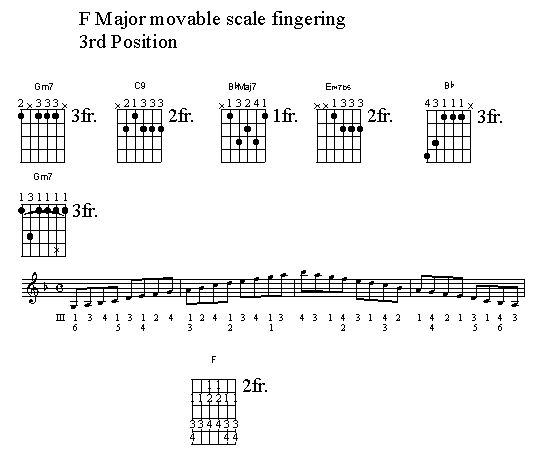
Fingering 1
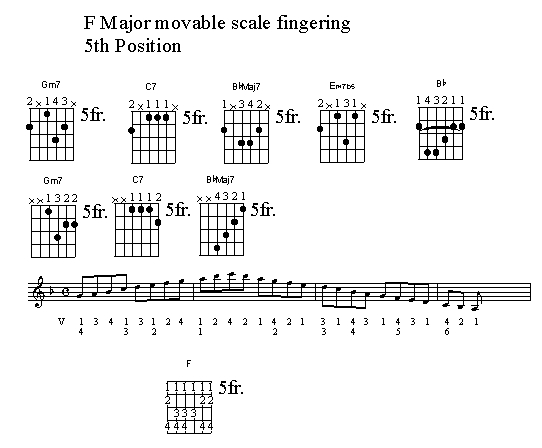
Fingering 2
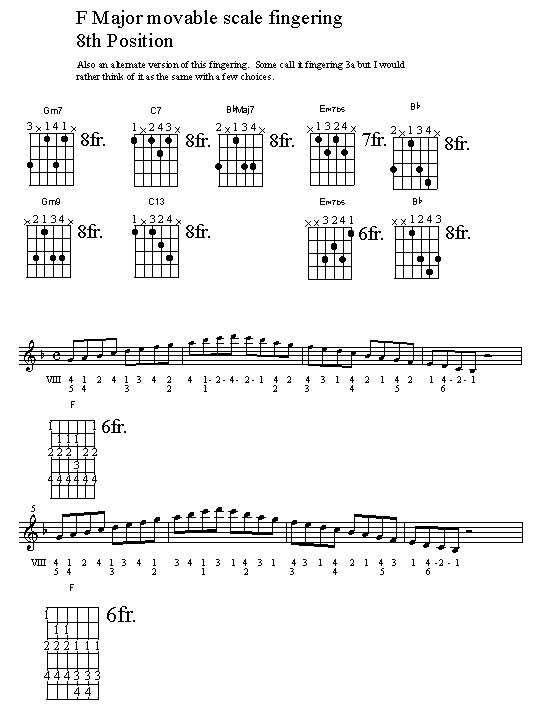
Fingering 3
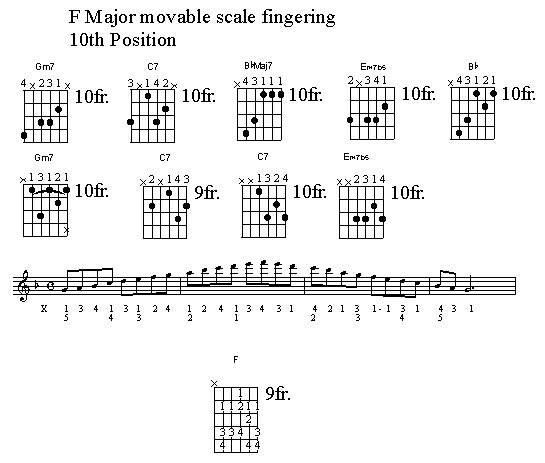
Fingering 4
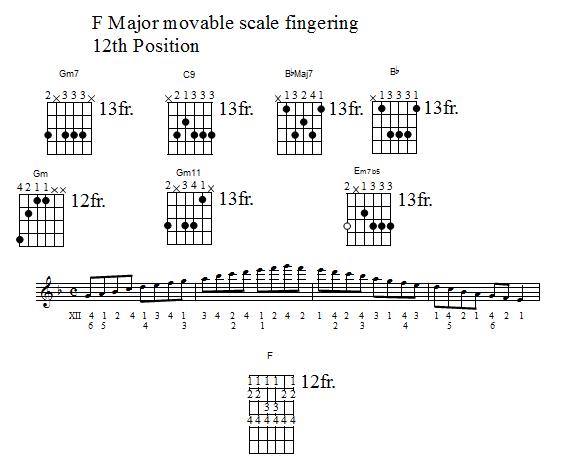
Fingering 5
PRACTICE: The next step.
The above method is just to learn the fingerings. Playing the scales up and down can be very useful and will build technique, but... after learning the fingerings it makes more sense to practice melodic patterns that you will actually want to use at times as slow melodies or double time lines. It will teach your ear a more melodic approach to hearing in tempo while coordinating with your hands for automatic recall when just recalling the sound of a melodic line.
There are many different types of melodies constructed out of different types of intervals and patterns. I have particular types I like and you will find the same or your own. I will try to include some examples, but for now here are some sources of melodic ideas you could use to start with that I recommend.
Both can be found at http://www.chordmelody.com in the Jazz guitar books section and the Jazz guitar video section. Both are invaluable when it comes to building technique and melodic awareness at the same time.
Pat Martino - Linear Expressions
Jackie King - Contemporary Guitar Improvisation - Video
Page Last Updated: October 18, 2014 | Email: cgrey0224@comcast.net

